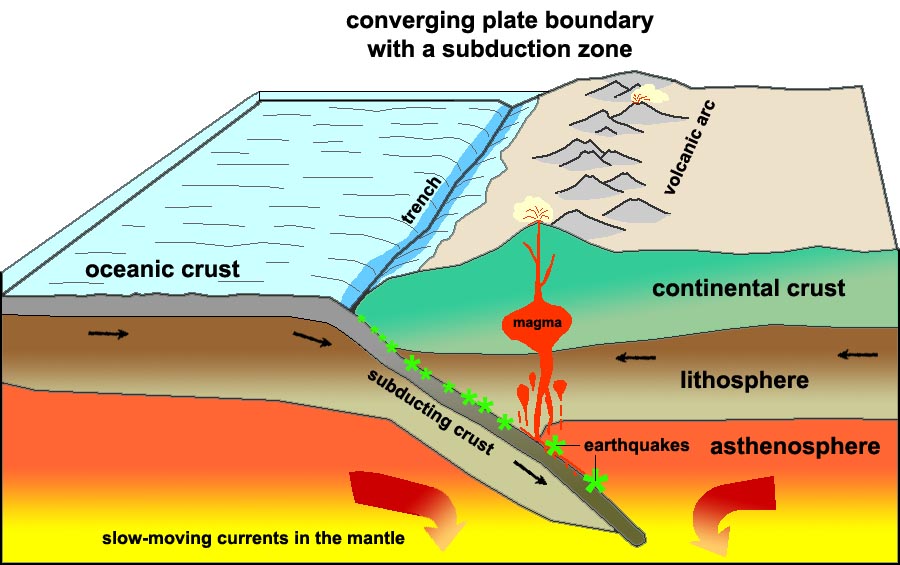Where Is Old Oceanic Crust Destroyed
The age of the oceanic crust does not go back farther than about 200 million years. Failed rifts are the result of continental rifting that failed to continue to the point of break-up.
Oceanic Crust That Sinking Feeling Metageologist
Facing each other but slowly moving in opposite directions as they transport newly formed oceanic crust away from the ridge crest.

. Any organismal remnants are destroyed by the extreme heat of the lava. Many ophiolites are much older than the oldest oceanic crust demonstrating continuity of the formation processes over hundreds of millions of years. The upward movement and eventual cooling of this magma has created high ridges on the ocean floor over millions of years.
Continental plates are rarely destroyed. The lithosphere consists of ___ ___ __ ____ __ ___ ____ _. One paleogeographic region is Pangaea the supercontinent that existed millions of years ago during the Paleozoic and Mesozoic eras.
Continental plate is the thick part of the earths crust which forms the large land masses. May be formed from either igneous or sedimentary rock. Other ancient sediments and lavas occur in the 385-billion-year-old Isua belt of western Greenland which is similar to an accretionary wedge in the trench of a modern subduction zone and the 35-billion-year-old Barberton Complex in South Africa which is probably a slice of oceanic crust.
This is also a rift-valley and the water floods it created a mid-ocean ridge where the crust breaks apart. These have granite with its abundant silica aluminum sodium and potassium. Both types of crust and the uppermost mantle.
Tension pulls the crust apart and a normal fault is created as well as the crust becoming thin enough for magma to come through it and create a volcano. The Proterozoic Eon extended from 25 billion to 541 million years ago and is often divided into the Paleoproterozoic 25 billion to 16 billion years ago the Mesoproterozoic 16 billion to 1 billion years ago and the Neoproterozoic 1 billion to 541 million years ago eras. Such crust is being formed today at oceanic spreading centres.
Like continental crust however oceanic crust is destroyed in subduction zones. Proterozoic Eon the younger of the two divisions of Precambrian time the older being the Archean Eon. Metamorphic rock whose crystal structure is altered by extreme heat and high pressure when buried miles deep in the Earths crust.
Seafloor spreading is the process of magma welling up in the rift as the old crust pulls itself in opposite directions. This submerged mountain range which extends from the Arctic Ocean to beyond the. Destroyed back-arc basins and subducted mid-ocean ridges have been restored based on combined evidence from preserved magnetic lineations fracture zones geological data from overriding plates including accreted terranes and the rules of plate tectonics that demand continuity of all plate.
New oceanic crust is. Any fossils contained in sedimentary rock are destroyed during the transformation to metamorphic rock. Cold seawater cools the magma creating new crust.
This recycling of the seafloor also explained why the oldest. The East Pacific Rise is a site of major seafloor spreading in the Ring of. On this map of the south Atlantic why is the.
A trench where an ocean plate is sinking back into the mantle. Oceanic crust is recognized as a significant sink for. A huge pulse in the formation of island arcs and oceanic plateaus took place.
This interval is approximately the time needed for the ocean floor to move from the ridge crest to the trenches where oceanic crust descends into the trench and is destroyed. Meanwhile magma is continually rising along the mid-oceanic ridges where the recycling process is completed by the creation of new oceanic crust. 20 PLATES AND PLATE MOTION By the late 1960s the ideas of continental drift and sea floor spreading had been combined into the theory of plate tectonics.
Spreading along the Atlantic ridge added seafloor to plates on both sides while subduction has consumed large areas of old oceanic crust in the Pacific. Due to plate tectonics or the movement of the Earths crust geographic regions are constantly being created and destroyed over time. The oldest oceanic rocks are less than 200 million years old.
Therefore old sea floor is continually being destroyed at trenches while new sea floor is being formed at the ridge crest see Figure 1214 page 319. That means that old crust must be destroyed somewhere so opposite a spreading center there is usually a subduction zone. Paleogeography is the study of these ancient environments.
Convergent boundaries -- where crust is destroyed as one plate dives under another. Typically the transition from rifting to spreading develops at a triple junction where three converging rifts meet over a. This constant process of creating new ocean crust and destroying old ocean crust means that the oldest ocean crust on Earth today is only about 200 million years old.
Continental rock has lower density than oceanic rock. A convergent plate boundary is most likely associated with an. They are mostly made of felsic rocks.
Major rifts occur along the central axis of most mid-ocean ridges where new oceanic crust and lithosphere is created along a divergent boundary between two tectonic plates. Perhaps the best known of the divergent boundaries is the Mid-Atlantic Ridge.

Oceanic Crust Geology Britannica

Earth Crust Oceanic Crust Vs Continental Crust Earth How

Hey Remember 7 Months Ago When You Were Barely In 8th Grade Ppt Download

No comments for "Where Is Old Oceanic Crust Destroyed"
Post a Comment